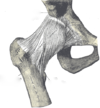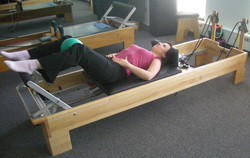
Hip Joint consisting of the Femur and Pelvic bone
This joint has the capability of moving in 8 different directions and because of inappropriate use often gives us an area of pain that is unnecessary. The many methodologies used in PT, MT, and most forms of physical medicine address the pain but rarely the cause. How I like to explain this joint to my clients is that it is meant to pivot around an axis. By that I mean the hip joint is not meant to be the primary joint of walking, standing and/or running. It is meant to be the transitional joint when moving to a standing position or bending forward, it really is not made for any significant amount of torsion.

The hip is a delicate joint that is often overworked and because of the musculature that surrounds it can create many problems. The Piriformis muscle attaches to the Femur and when that muscle is involved the Sciatic nerve can be involved. The Psoas Major muscle if compromised by an imbalance to the hip joint can also encumber the Lumbar spine. The Gluteal muscles also connect here and with the interconnection of the Lattismus Dorsi with the Gluteus Maximus shoulder issues could be possible. Once again we strengthen muscles that create an unnatural tensegral pull on the skeleton that eventually creates a stress point that will contribute to pain. As you can see there are many areas that come into play if the hip joint is wrongly used.
So if you are treating someone with hip discomfort, or are someone who is suffering from long term hip pain, remember you have altered movement patterns that have created compensation. It is important that we prevent chronic hip pain by maintaining a positive tension on the skeletal structures and we are cautious with our movement patterns. On our web site we have archived You Tube videos of our Movement of the Month (www.chagrinvalleywellness.com) that shows how we reprogram the neurological system to educate the body into properly moving. Many times the pain will continue to reappear until we change the movement pattern, that is what our Fundamental Movement Therapy(SM) accomplishes.
I encourage individuals who suffer from chronic hip pain or therapists that struggle treating this painful condition to contact us at [email protected]. If you know someone who suffers from this and would benefit from a consultation session, either at our office or on the phone, forward this blog to them. In the next few blogs I will be including videos that further show how to determine the proper Q angle and how to help recreate it. We will also be continuing on with the knee, ankle and foot and some tips on how to prevent these painful happenings. Thank you and please enjoy the holiday season.
A Reason and Season of HOPE!
Dennis
 RSS Feed
RSS Feed
